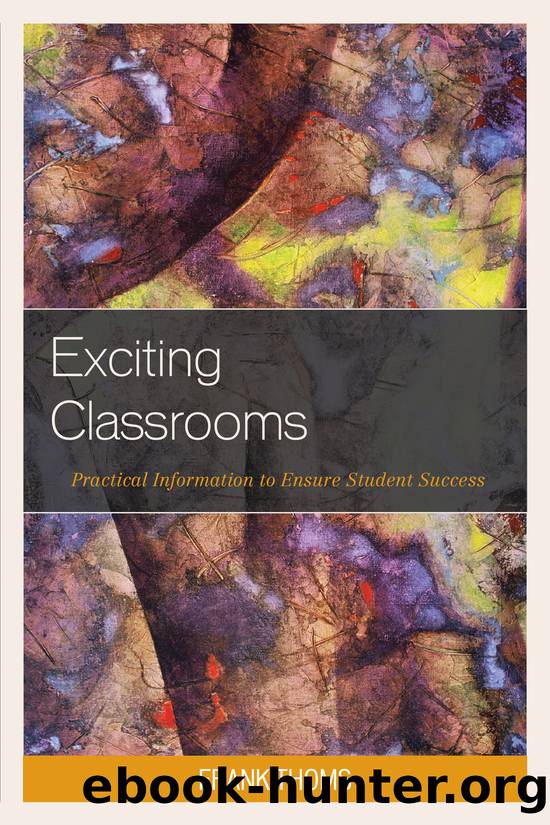Exciting Classrooms by Thoms Frank;

Author:Thoms, Frank;
Language: eng
Format: epub
Publisher: Rowman & Littlefield Publishers, Incorporated
Chapter 12
Stop the Interruptions
It has to do with power. Every time anyone shamelessly interrupted my class, the message was clear: âMy time is more valuable than yours. Whatever youâre doing cannot possibly be as vital as whatever Iâm doing.â
Why do teachers have to struggle to find uninterrupted time? What in the school psyche allows office personnelâprincipals, guidance, and secretariesâto interrupt over the public address system (PA)? What allows janitors during classes to operate floor-cleaning machines in the hallways or lawn mowers outside windows? People claim that teachers are an essential piece in a childâs education, yet such actions in schools undermine their efforts.
Coleen Armstrong is right. Whatever she is doing in her classroom is not as valuable as what others do. It is a power struggle.1 But an unnecessary power struggle, an unjustified power struggle. Successful businesses put customers first, so schools should put teachers and students first. When the principal interrupts over the PA, the lesson disappears! Depending on the length of the announcement and its content, returning to the lessonâif possibleâcan take several minutes. âWill the following students please come to the office?â has an even more emotional impact.
Patti Grenier, former superintendent of schools in Barnstable, Massachusetts, and now a consultant at Teachers21, shared at a workshop that an average of seven minutes are lost with each PA announcement. Think about that. If five interruptions occur during the day, thirty-five minutes of teaching is lost. For a week, that means three hours! For thirty-six weeks, forty-eight hours!
Armstrongâs insight is the-emperor-is-not-wearing-any-clothes exposeâ of this travesty. In dire contrast, in Japan, the classroom is considered sacred. Learning takes priority. No interruptions are tolerated.2 In contrast, in American schools, where interruptions are the order of the day, Japanese visitors flinch when the PA (Big Brother?) issues a commandâor when teachers barge in on one another.
This last comment deserves scrutiny. If you are a teacher, how often do you drop in on other teachers in the middle of the period to borrow something or simply to say hello? How often do you interrupt your own students during a lesson instead of letting them have extended time? Have you thought about suggesting to your colleagues to consider the impact of the traditional assembly-line schedule of forty-to-forty-fiveâminute periods? How might you make it a point to advocate for more uninterrupted learning time?
Lorraine Hong offers a different perspective from Armstrong, one that is more subtle and perhaps more insidious.3 Hong describes how increasing intrusions caused her to lose her passion for teaching. In her school as part of an hour-long writing period, the principal told her and her fifth-grade colleagues to include ten minutes of keyboarding. While her principal considered this a simple request, by the time the computers were set up and students settled, the lesson took fifteen to twenty minutes to implement.
Later, a new math curriculum was put in place that required teaching sixty minutes per day. Hong found it impossible to schedule it on Mondays and Fridays, because students were required to leave for âgiftedâ programs and for special-education pullouts.
Download
This site does not store any files on its server. We only index and link to content provided by other sites. Please contact the content providers to delete copyright contents if any and email us, we'll remove relevant links or contents immediately.
The Art of Coaching Workbook by Elena Aguilar(51000)
Trainspotting by Irvine Welsh(21521)
Twilight of the Idols With the Antichrist and Ecce Homo by Friedrich Nietzsche(18509)
Fangirl by Rainbow Rowell(9104)
Periodization Training for Sports by Tudor Bompa(8173)
Change Your Questions, Change Your Life by Marilee Adams(7638)
This Is How You Lose Her by Junot Diaz(6800)
Asking the Right Questions: A Guide to Critical Thinking by M. Neil Browne & Stuart M. Keeley(5652)
Grit by Angela Duckworth(5525)
Red Sparrow by Jason Matthews(5392)
Paper Towns by Green John(5092)
Room 212 by Kate Stewart(5041)
Ken Follett - World without end by Ken Follett(4647)
Housekeeping by Marilynne Robinson(4349)
The Sports Rules Book by Human Kinetics(4299)
Double Down (Diary of a Wimpy Kid Book 11) by Jeff Kinney(4209)
Papillon (English) by Henri Charrière(4199)
The Motorcycle Diaries by Ernesto Che Guevara(4018)
Exercise Technique Manual for Resistance Training by National Strength & Conditioning Association(3960)
